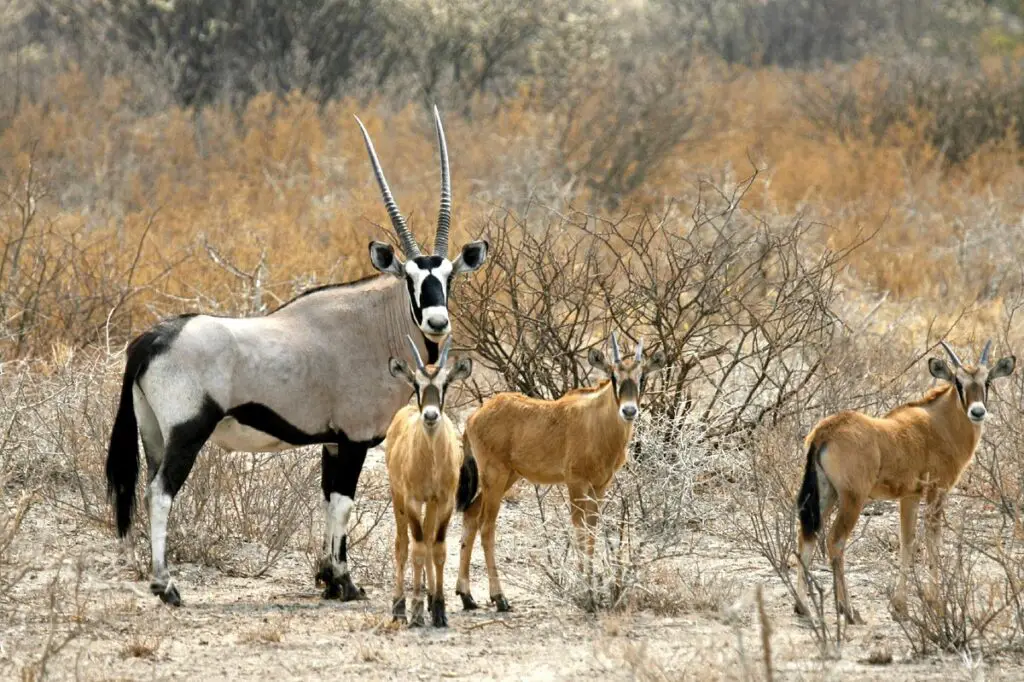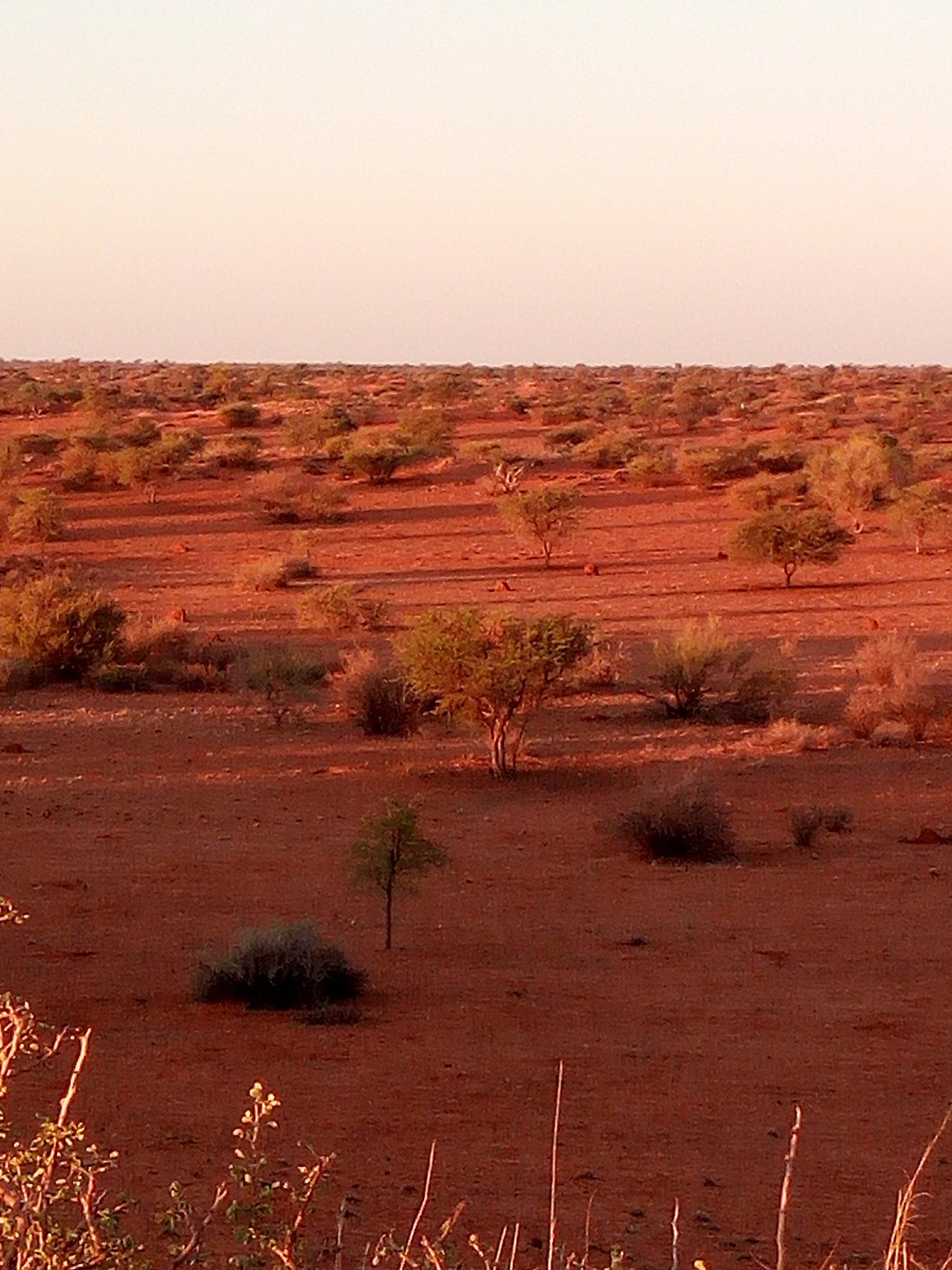The Kalahari Desert is a vast, semi-arid sandy savannah that stretches over approximately 900,000 square kilometers, spanning three countries in Southern Africa: Botswana, Namibia, and South Africa.
Despite being referred to as a desert, the Kalahari experiences more rainfall than a typical desert should — between 5 and 10 inches annually — and supports a relatively diverse range of life.
The landscape of the Kalahari is characterized by extensive grasslands, sparse trees, and arid regions. The sand dunes, colored from white to a rich ochre, give it an almost otherworldly beauty. The desert is also famous for its red sand, which owes its color to a high iron oxide content.
In terms of natural resources, the Kalahari Desert is rich in minerals, including diamonds, which have been a major factor in Botswana’s economic development.
The desert also plays a significant role in promoting ecotourism, with several game reserves and national parks offering safaris and guided tours that highlight the region’s unique biodiversity and geology.
This article explores other interesting facts about the Kalahari desert.
The Kalahari is Not a True Desert
The Kalahari Desert, despite its name, is not a true desert. It receives too much rainfall – between 5 and 10 inches annually. This rainfall supports a variety of life not typically found in deserts, such as certain types of vegetation and wildlife.
Annual precipitation ranges between 125 mm to 250 mm (about 5 to 10 inches), and in some parts, it can even reach up to 500 mm (20 inches). This is significantly more than what true deserts like the Sahara or the Atacama receive.
So while the Kalahari has the word “Desert” in its name and exhibits many desert-like qualities, its levels of rainfall, vegetation, and wildlife biodiversity actually categorize it more accurately as a semi-desert or a desert savannah.
Spanning Three Countries
Botswana: The majority of the Kalahari Desert lies within the borders of Botswana. It is home to the Central Kalahari Game Reserve, one of the largest protected areas in Africa, which was originally established to protect the traditional territory of the San people, the desert’s indigenous inhabitants. Botswana’s portion of the Kalahari is famous for its diamond mines, which contribute significantly to the country’s economy.
Namibia: The eastern part of Namibia covers a portion of the Kalahari. Namibia’s Kalahari is marked by red sand dunes covered by a surprising variety of vegetation, from trees and shrubs to grasses. Game species such as antelope and giraffes can be found here, along with smaller wildlife and bird species.
South Africa: The Kalahari Desert extends into the northern parts of South Africa, particularly within the Northern Cape Province. Here, it transitions into the bushveld towards the east.
The Kgalagadi Transfrontier Park, one of the largest wildlife conservation areas in the world, straddles the border between South Africa and Botswana and is a notable feature of the Kalahari in South Africa.
In each of these countries, the Kalahari Desert has a different character influenced by the local climate, elevation, and human activity. Despite the challenging conditions, it is home to an array of fauna and flora, and human communities have lived here for thousands of years, attesting to the region’s rich ecological and cultural diversity.
Unusual Wildlife Adaptations

Despite the harsh conditions, the Kalahari hosts numerous large mammals. These include predators such as lions, cheetahs, leopards, and hyenas. It’s particularly well-known for the black-maned Kalahari lions. Herbivores such as elephants, giraffes, zebras, and a variety of antelopes like the springbok, gemsbok (Oryx), and kudu also inhabit the region. Smaller mammals include meerkats, various mongoose species, and the bat-eared fox.
The Kalahari is a bird watcher’s paradise, home to over 300 recorded bird species. Raptors like the Martial eagle and vultures are commonly sighted. Other notable species include the African fish eagle, Kori bustard, and secretary bird. The region’s seasonal wetlands draw numerous migratory birds during the rainy season.
The Kalahari is a hotspot for reptiles including numerous snake species such as the black mamba, puff adder, and Cape cobra. You’ll also find lizards like the Kalahari ground agama, geckos, and the endangered African spurred tortoise.
Insect life is abundant in the Kalahari. Dung beetles, locusts, and numerous butterfly and moth species are common. The desert also hosts a variety of spiders, scorpions, and other arachnids.
During the rainy season, the Okavango Delta region in the Kalahari becomes a lush, water-filled paradise, attracting hippos, crocodiles, and a wide range of fish species.
The life in the Kalahari is a testament to the resilience and adaptability of nature, demonstrating how a diverse range of species can thrive even in the most challenging conditions. Conservation efforts are ongoing in the region to protect this incredible biodiversity and to ensure the survival of threatened and endangered species.
Unique and Rare Plant Species

The Kalahari Desert’s relatively high annual rainfall supports a variety of plant species adapted to withstand the region’s semi-arid conditions. While the vegetation is predominantly grasses and shrubs, there are also a number of unique and interesting plant species native to the region:
Camel Thorn Trees (Acacia erioloba): One of the most common and iconic trees of the Kalahari, the Camel Thorn is well-adapted to the desert environment. It has a deep root system that allows it to access groundwater, and its seeds provide a valuable source of food for many animals.
Shepherd’s Trees (Boscia albitrunca): These trees are another common sight in the Kalahari. They have a unique water storage system in their trunks and are able to thrive even in extremely arid conditions.
Silver Terminalia (Terminalia sericea): This is a resilient shrub species often found in sandy areas of the Kalahari. It provides both food and shelter for a variety of desert-dwelling creatures.
Hoodia Gordonii: This unusual succulent plant is native to the Kalahari Desert. It’s known for its appetite-suppressing properties and has been used by the San people for centuries to stave off hunger during long hunting trips.
Devil’s Claw (Harpagophytum procumbens): Named for its claw-like fruit, Devil’s Claw is a ground-cover plant found in the Kalahari. It has been used in traditional medicine for its anti-inflammatory properties.
Buffalo Grass (Cenchrus ciliaris): This grass species is able to survive in the arid conditions of the Kalahari, providing an important food source for many herbivores in the region.
Wild Watermelon (Citrullus lanatus): Also known as the Tsamma melon, it serves as an essential water source for animals and humans during the dry season.
Kalahari Christmas Tree (Euphorbia gregaria): These succulent plants have adapted to store water in their stems to withstand long periods of drought. During the rainy season, they produce bright yellow flowers, hence the name “Christmas Tree.
These plant species, with their unique adaptations, form an integral part of the Kalahari ecosystem, providing food, shelter, and maintaining the balance of nature in this semi-arid desert environment.
Surprising Rainfall Patterns

While the Kalahari is classified as a semi-arid region, its rainfall patterns are more akin to those found in more temperate savannah regions than in true deserts.
The Kalahari receives between 125 and 250 mm (5 to 10 inches) of rainfall annually, and in some areas, it can even reach up to 500 mm (20 inches). This is significantly higher than what true deserts like the Sahara or the Atacama receive, and it allows for a surprising diversity of plant and animal life.
The majority of this rainfall occurs during the summer months, which are between November and April. During this period, localized, heavy thunderstorms are common, especially in the afternoon or evening. This rainy season is followed by a dry season from May to October, when little to no rainfall occurs. This stark contrast between the wet and dry seasons is a characteristic feature of the Kalahari’s climate
The seasonal rains transform parts of the Kalahari into lush, green landscapes. Grasslands spring to life, providing food for herbivores, which in turn attract predators, leading to a thriving ecosystem. Certain regions, like the Nxai Pan National Park, become a haven for migratory birds and animals during this time.
Rainfall in the Kalahari also varies geographically. The southern parts of the desert receive less rainfall compared to the more northern regions. This results in differing vegetation types, with more grasslands in the north and more desert-like conditions in the south.
Despite these general patterns, rainfall in the Kalahari is notoriously unpredictable. Some years may see significantly higher or lower rainfall than average, which can impact both wildlife populations and human activities, such as farming and herding, in the region.
Despite the harsh conditions and the desert moniker, these surprising rainfall patterns contribute to the Kalahari’s standing as one of the most biodiverse semi-arid regions in the world.
Extreme Temperature Fluctuations
The Kalahari experiences its summer from November to April. During this period, daytime temperatures can be extremely high, often exceeding 40°C (104°F). However, the summer also brings rain, which can temporarily cool the environment.
In contrast, the winter months (May to October) see milder temperatures during the day, usually between 20°C and 27°C (68°F – 80°F). However, it is not uncommon for night-time temperatures to drop near or below freezing, particularly in the months of June, July, and August.
These extreme temperature variations have shaped the behavior and adaptations of the flora and fauna that inhabit the Kalahari Desert. Many animals are nocturnal, avoiding the intense heat of the day, while many plants have adaptations that allow them to conserve water and survive in the hot conditions.
The Ancient San People
The San people, also known as Bushmen, are indigenous inhabitants of Southern Africa and have lived in the Kalahari Desert for over 20,000 years. They are considered to be one of the oldest cultures in the world and hold a wealth of knowledge about the harsh desert environment.
The San people were traditionally hunter-gatherers, surviving off the land by hunting wild game with bows and poisoned arrows and gathering edible plants, fruits, and roots. They are famous for their tracking skills and knowledge of the desert, able to find water and food where others might see only an inhospitable wilderness.
The San people speak a variety of languages, most of which are characterized by ‘click’ consonants, a feature that is relatively rare in the world’s languages. These languages form the Khoisan language family, though each San community may have its unique dialect.
The San are well known for their rock art and oral storytelling traditions. Their rock paintings and engravings, found on cave walls and rock shelters throughout the region, are considered among the world’s oldest art. These works often depict scenes of hunting, animal and human figures, and shamanic rituals.
The San people have a rich spiritual life, with a belief system that emphasizes the interdependence of all creatures and elements in the universe. They traditionally practiced shamanism and ancestral spirit worship. Trance dance is a key part of their religious rituals, where healing and community bonding take place.
Despite their deep cultural heritage, the San people face numerous challenges today. Their traditional lands have been encroached upon by farming, mining, and the establishment of nature reserves. They have been subjected to displacement, economic marginalization, and cultural assimilation. However, there are ongoing efforts to preserve their cultural heritage, protect their land rights, and promote their sustainable lifestyle.
The San people’s extensive knowledge of the Kalahari’s ecology, passed down through generations, makes them an invaluable part of the region’s heritage and biodiversity. Their resilience and adaptation to the harsh desert environment are truly remarkable.
Diamond Reserves
The Kalahari Desert, particularly within Botswana, is known for its significant diamond reserves. These precious resources have had profound impacts on the region’s economy, industrial development, and even its natural and human landscapes.
The discovery of diamonds in Botswana in the late 1960s transformed the country’s economic prospects. Today, Botswana is the world’s second-largest producer of diamonds (by value), after Russia. Diamonds account for a substantial portion of Botswana’s GDP and export earnings.
The largest and most significant diamond mine in the Kalahari is the Jwaneng mine, owned by Debswana, a joint venture between the De Beers Group and the government of Botswana. Jwaneng is often described as the richest diamond mine in the world by value. Other key diamond mines in the region include the Orapa and the Letlhakane mines.
The Presence of Other Important Minerals and Metals
While the Kalahari Desert is best known for its diamond reserves, especially in Botswana, it is also rich in several other important minerals and metals. Some of these resources are currently being mined, while others are known to exist but are not being extensively exploited at present.
Copper: The Kalahari Copper Belt, spanning Botswana and Namibia, holds significant copper deposits. There are several active mining projects in this region, and exploration continues to identify more reserves.
Uranium: Namibia, in the western part of the Kalahari, is one of the world’s largest producers of uranium. The Husab Mine and the Rössing uranium mine, among the largest uranium mines globally, are located in Namibia.
Coal: Botswana’s eastern Kalahari Basin has substantial coal deposits. While the country’s coal industry is less developed than its diamond industry, there’s potential for growth, especially with the increasing demand for cleaner coal technologies.
Gold: Some gold deposits have been found in the Kalahari, particularly in eastern Namibia. Gold mining is not currently a major industry in the region, but exploration continues.
Rare Earth Elements: The region holds potential for rare earth elements, which are critical for many modern technologies such as cell phones, electric vehicles, and renewable energy systems. Namibia, in particular, is known for having a variety of these elements.
Salt and Soda Ash: The Makgadikgadi Pans in Botswana, a large salt pan in the middle of the dry savanna of northeastern Botswana, are a significant source of salt and soda ash.
Gems and Semi-Precious Stones: The Kalahari Desert is known for various gems and semi-precious stones, including garnets and tourmalines. These are particularly found in Namibia.
These resources have the potential to contribute significantly to the region’s economy. However, extracting them needs to be balanced against potential environmental impacts and the rights and needs of local communities.
Promotes Eco-tourism
The Kalahari Desert, with its distinctive landscape, diverse wildlife, and rich cultural heritage, provides numerous opportunities for eco-tourism. Eco-tourism focuses on responsible travel to natural areas that conserves the environment, sustains the well-being of the local people, and involves interpretation and education. The Kalahari promotes eco-tourism in several ways:
The Kalahari is home to several protected areas, including the Kgalagadi Transfrontier Park, Central Kalahari Game Reserve, and the Khutse Game Reserve. These parks offer opportunities for game viewing and bird watching, and they help protect the region’s unique flora and fauna. Eco-friendly accommodations and guided safaris in these areas emphasize minimizing environmental impact and educating tourists about the ecosystem.
Eco-tourism in the Kalahari also includes opportunities to learn about the indigenous cultures, particularly the San people. Some tour operators offer guided walks or visits to local communities where tourists can learn about the San people’s traditional ways of life, their knowledge of the desert environment, and their art.
Many tour operators and lodges in the Kalahari focus on sustainability, implementing practices such as solar power, water conservation, waste recycling, and sourcing locally-produced food. They may also contribute a portion of their profits to local conservation efforts or community development projects.
Eco-tourism often has an educational component, and many Kalahari tours offer information about the desert’s ecosystem, wildlife, and conservation challenges. This helps tourists appreciate the region’s biodiversity and understand the importance of protecting it.
Eco-tourism can provide important economic benefits for local communities, offering employment opportunities and supporting local crafts and industries. This is crucial for sustainable development in the region.


